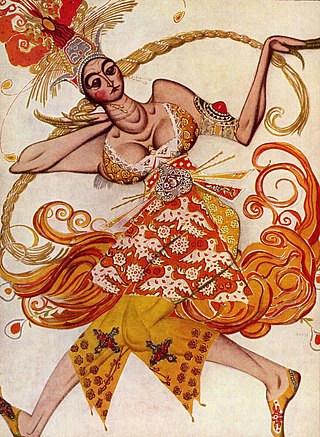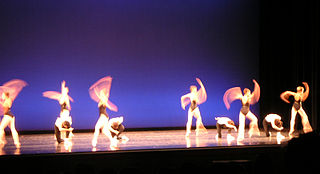Related Research Articles

Igor Fyodorovich Stravinsky was a Russian composer and conductor with French citizenship and American citizenship. He is widely considered one of the most important and influential composers of the 20th century and a pivotal figure in modernist music.

George Balanchine was a Georgian-American ballet choreographer, recognized as one of the most influential choreographers of the 20th-century. Styled as the father of American ballet, he co-founded the New York City Ballet and remained its artistic director for more than 35 years. His choreography is characterized by plotless ballets with minimal costume and décor, performed to classical and neoclassical music.

New York City Ballet (NYCB) is a ballet company founded in 1948 by choreographer George Balanchine and Lincoln Kirstein. Balanchine and Jerome Robbins are considered the founding choreographers of the company. Léon Barzin was the company's first music director. City Ballet grew out of earlier troupes: the Producing Company of the School of American Ballet, 1934; the American Ballet, 1935, and Ballet Caravan, 1936, which merged into American Ballet Caravan, 1941; and directly from the Ballet Society, 1946.

The Firebird is a ballet and orchestral concert work by the Russian composer Igor Stravinsky. It was written for the 1910 Paris season of Sergei Diaghilev's Ballets Russes company; the original choreography was by Michel Fokine, who collaborated with Alexandre Benois and others on a scenario based on the Russian fairy tales of the Firebird and the blessing and curse it possesses for its owner. It was first performed at the Opéra de Paris on 25 June 1910 and was an immediate success, catapulting Stravinsky to international fame and leading to future Diaghilev–Stravinsky collaborations including Petrushka (1911) and The Rite of Spring (1913).

Darci Kistler is an American ballerina. She is often said to be the last muse for choreographer George Balanchine.
The Capriccio for Piano and Orchestra was written by Igor Stravinsky in Nice between 1926 and 1929. The score was revised in 1949.

Igor Stravinsky composed his Mass between 1944 and 1948. This 19-minute setting of the Roman Catholic Mass exhibits the austere, Neoclassic, anti-Romantic aesthetic that characterizes his work from about 1923 to 1951. The Mass also represents one of only a handful of extant pieces by Stravinsky that was not commissioned. Part of the motivation behind its composition has been cited by Robert Craft and others as the product of a spiritual necessity, as Stravinsky intended the work to be used functionally.

Igor Stravinsky's Violin Concerto in D is a neoclassical violin concerto in four movements, composed in the summer of 1931 and premiered on October 23, 1931. It lasts approximately twenty minutes.

Apollo is a neoclassical ballet in two tableaux composed between 1927 and 1928 by Igor Stravinsky. It was choreographed in 1928 by twenty-four-year-old George Balanchine, with the composer contributing the libretto. The scenery and costumes were designed by André Bauchant, with new costumes by Coco Chanel in 1929. The scenery was executed by Alexander Shervashidze, with costumes under the direction of Mme. A. Youkine. The American patron of the arts Elizabeth Sprague Coolidge had commissioned the ballet in 1927 for a festival of contemporary music to be held the following year at the Library of Congress in Washington, D.C.

Agon is a 22-minute ballet for twelve dancers with music by Igor Stravinsky. It was choreographed by George Balanchine. Stravinsky began composition in December 1953 but was interrupted the next year; he resumed work in 1956 and concluded on April 27, 1957. The music was premiered in Los Angeles at UCLA's Royce Hall on June 17, 1957, conducted by Robert Craft. Stravinsky himself conducted the sessions for the work's first recording the following day on June 18, 1957. Agon was first performed on stage by the New York City Ballet at the City Center of Music and Drama on December 1, 1957.

Ask la Cour Rasmussen is a Danish ballet dancer. He joined the Royal Danish Ballet in 2000, then moved to the New York City Ballet in 2002, and was promoted to principal dancer in 2013. He retired from the company in 2021.
Circus Polka: For a Young Elephant was written by Igor Stravinsky in 1942. He composed it for a ballet production that the choreographer George Balanchine did for Ringling Bros. and Barnum & Bailey Circus. The ballet was performed by fifty elephants and fifty ballerinas. In 1944, Stravinsky published an orchestration of the piece, which is now part of the repertoire of many orchestras.
Elegy is a composition by Igor Stravinsky for solo viola composed in 1944. It was dedicated to the memory of Alphonse Onnou, the founder of the Pro Arte Quartet. The score bears no time signature, but the metronome marking sets the tempo at = 56. The opening section is in the style of a chant above a rippling accompaniment. The middle section contains elements of a fugue, though there are never more than two independent voices. After its climax, the Elegy closes with a recapitulation of its opening. The viola is directed to play with mute throughout.

Diana Adams was a principal dancer for the New York City Ballet from 1950 to 1963 and favorite of George Balanchine, later becoming a teacher at — and dean of — the School of American Ballet.
Variations: Aldous Huxley in memoriam is Igor Stravinsky's last major orchestral composition, written in 1963–64.

Allegro Brillante is a ballet choreographed by George Balanchine to Tchaikovsky's Piano Concerto No. 3. The ballet is danced by a principal couple and a corps de ballet of eight. Balanchine said it "contains everything I knew about classical ballet." Allegro Brillante was made for the New York City Ballet, and premiered on March 1, 1956, at the City Center of Music and Drama, with Maria Tallchief and Nicholas Magallanes originating the two principal roles.
Heléne Alexopoulos is an American retired ballet dancer. She was a student of Maria Tallchief who was discovered by George Balanchine as a teenager. She joined the New York City Ballet in 1978, she was promoted to principal dancer in 1989, and she retired in 2002.
Movements for Piano and Orchestra is a neoclassical ballet choreographed by George Balanchine to Stravinsky's score of the same name. The ballet premiered on April 9, 1963, at City Center of Music and Drama, performed by the New York City Ballet. Though the two lead roles were created for Diana Adams and Jacques d'Amboise, seventeen-year-old Suzanne Farrell danced the female lead at the premiere due to Adams' pregnancy. Starting in 1966, Movements and Monumentum pro Gesualdo (1960) are performed together.
References
- ↑ White 1979, p. 550.
- ↑ White 1979, p. 551.
Cited source
- White, Eric Walter (1979). Stravinsky: The Composer and his Works (2nd ed.). University of California Press. ISBN 978-0520039834.